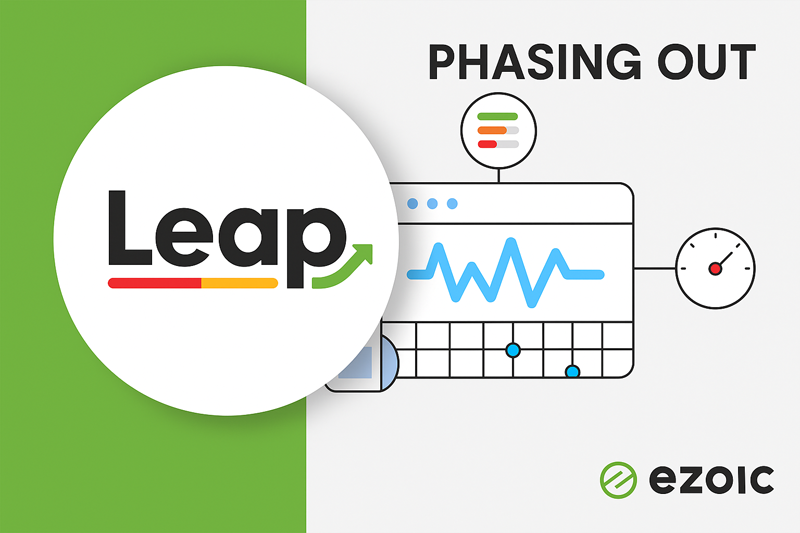Ezoic is Phasing Out Leap: Why JavaScript Integration Matters Now More Than Ever
Ezoic is a platform that helps website owners increase their ad revenue by optimizing ad placement and performance with the help of AI. It offers three different ways to integrate with your website: Ezoic CDN Integration, Cloudflare CDN Integration, and JavaScript (JS) Integration. Each method has its own pros and cons in terms of performance, flexibility, and ease of setup.
Recently, Ezoic announced a major change: its Leap optimization tool will be discontinued starting May 12th, 2025. This is a significant shift, especially for site owners who relied on Leap to fix performance issues like slow page loads and poor Core Web Vitals scores.
I’ve already documented the performance hit I experienced with Ezoic CDN in my post My Experience with Ezoic: Traffic Drop After Switching from AdSense. That article details how, although revenue went up after switching from AdSense, I noticed a steep drop in traffic, clearly tied to performance degradation.
Although Ezoic claims that many of Leap's speed benefits are now automatically included in their Cloud (CDN) integration, they are also explicitly recommending JavaScript integration for users who want more control and flexibility over how their ads behave and load. This means JavaScript integration is no longer just an alternative—it’s now the go-to option for publishers who want to fine-tune ad performance and layout behavior on their sites.

My Experience with JavaScript Integration
Having used the JavaScript method in the past, I can confirm that it gives you much more control over how and when scripts load. You can optimize speed using third-party tools and manually set everything up to suit your needs.
But it comes with trade-offs.
In my post Comparing Ezoic CDN vs JavaScript Integration: My Experience & Insights, I laid out the pros and cons of each integration style. JavaScript made my site faster overall, but it caused two major issues:
- Delayed Ad Loading Increases Total Blocking Time (TBT):
With JS integration, ads load after the page is delivered to the browser. This results in a delay, and while the site content appears quickly, ad scripts can increase Total Blocking Time, affecting the Core Web Vitals score. - Above-the-Fold (ATF) Layout Shift (CLS Issue):
Unlike CDN integration, where Ezoic pre-calculates ad dimensions and reserves space before delivering the page, JS integration does not reserve space for above-the-fold (ATF) ads. The result? The page loads without ad space, and when the ad finally appears, it pushes content down, causing a Cumulative Layout Shift (CLS) problem.
Beyond these issues, you’ll also need to manually manage things like script injection, placeholder creation, and the ads.txt redirection.
Although the ad-related blocking time is a common challenge across most ad platforms (including AdSense), I found Ezoic slightly slower in comparison. To work around this, I usually lazy-load the ads to make sure the main content isn’t delayed. So, the most critical problem I encountered was the CLS issue with above-the-fold ads.
My Solution to the CLS Problem
Ezoic’s support confirmed that with JavaScript integration, they don’t control the ad space reservation. Instead, I was advised to experiment with adding whitespace manually to preserve layout stability.
To fix this, I defined placeholder heights using CSS for different screen sizes and ad positions. Here’s an example of what I implemented:
/* Ezoic Ads */
.ez-content-atf {
height: 280px;
}
@media only screen and (min-width: 992px) {
.ez-content-atf {
height: 100px;
}
.ez-panel-atf {
height: 250px;
}
}
@media only screen and (min-width: 1200px) {
.ez-panel-atf {
height: 280px;
}
}
/* End Ezoic Ads */I use two types of ads that show above the fold: one in the main content area and one in the side panel. On desktop, both ads appear above the fold. But on mobile devices, only the content area ad stays above the fold—the side panel ad gets pushed further down and shows below the fold.
I set the placeholder heights only for the screen sizes where the ads actually appear above the fold. I also chose specific heights based on the ad sizes I prefer for each screen size. You can experiment with different dimensions and adjust them to fit what works best for your website.
Then, I wrapped each ad placeholder with a <div> using the relevant class.
Main Content Area Example:
<div class="ez-content-atf">
<div id="ezoic-pub-ad-placeholder-109"></div>
</div>Side Panel Example:
<div class="ez-panel-atf">
<div id="ezoic-pub-ad-placeholder-104"></div>
</div>By pre-defining the height, I effectively avoided CLS, even with late-loading JS-based ads.
Final Thoughts
With Leap going away, publishers need to rethink how they handle performance on Ezoic. While the CDN integration now includes some automated performance improvements, Ezoic is clearly steering users toward JavaScript integration for greater control and flexibility. That said, JS integration brings new challenges, especially with Cumulative Layout Shift (CLS) caused by above-the-fold ads. If you decide to go this route, reserving space for ATF ads with CSS is a must-do step to avoid hurting your Core Web Vitals.
Comments
Insight is best when shared. Found it useful or confused by something? Leave a comment — your thoughts might help others and keep the discussion growing!